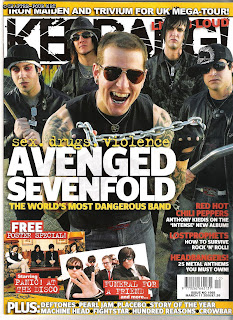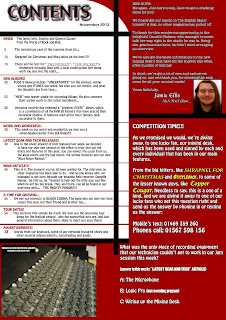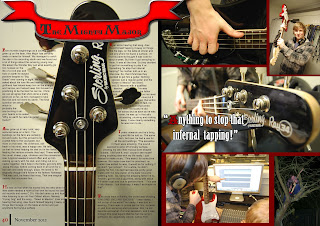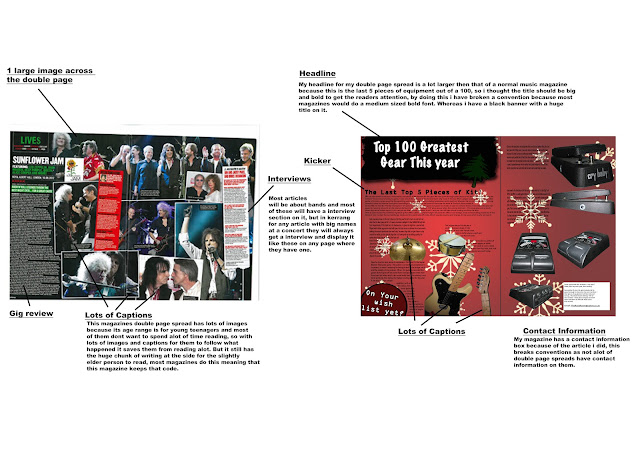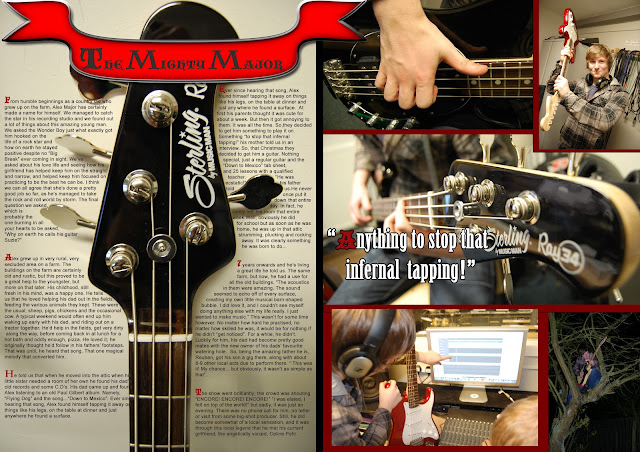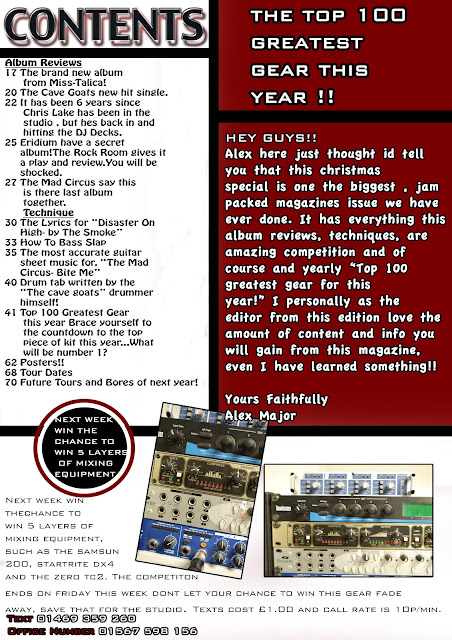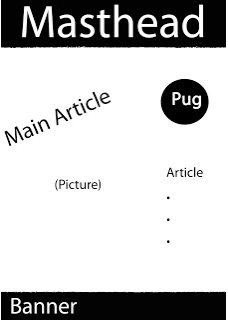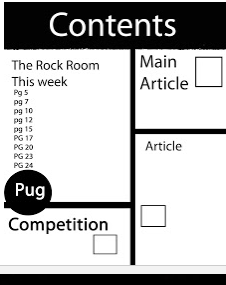My Magazine!
This is my front cover compared
to Kerrang magazine.
1) My magazine is less
cluttered than most, particularly the right side of Alex’s head. Looking at
Kerrang!s cover, we have about the same amount on the front cover, it’s just
their picture is alot more prominent and is covering the masthead. Their main
article picture is touching the text for their main article. Mine isn’t, which
is a convention I broke, but I don’t think I should’ve.
2) My magazine hasn’t got a very
eye-catching masthead, which I would change if I re-did my magazine. I decided
to keep the usual convention of having a banner at the bottom of my front page,
telling people the bands that would be featured in my magazine. I think the
strapline needed to be bigger to catch people’s attention, particularly fans of
who the main article would be about, so they’d buy that issue.
3) I have on this page a “pug”
about a competition inside my magazine, as this is what my target audience
survey wanted in their magazines, competitions. This pug is fairly big and
should be able to grab people’s attention.
4) I haven’t really pushed any sort
of convention for my magazine, given I didn’t want to make any sort of major
error in making it flawed. The things I would change are the brightness of the
colours used, and the lighting in my picture. Basically, i would make my front
cover page alot more eye catching.
Kerrang!
1) Kerrang! Magazine looks very cluttered, but that’s only
due to the picture being in the foreground and looking very prominent. They
have a similar amount of content being displayed, but they pictures and mine
doesn’t. This would be something I would need to change if I re-did my magazine.
Side from that, the only major difference is how bright the colours are on
Kerrang!. My colours are quite mellow and I would need to brighten them up,
instead of being just a dull brown and murky red.
2) Kerrang!s colour scheme for this issue is a bright
yellow. It’s very eye catching and the image on the front is as well. Their
strapline is huge, and covers nearly a ¼ of the space of the magazines front
cover. It’s in a bold white font that is easy to read from any reasonable
distance. They have the banner at the base of their front cover as well,
informing people about the bands featured.
3) Kerrang! Don’t have any pugs on their front cover;
however they’re advertising the fact that they have posters in their magazine,
which is a similar to me advertising a competition.
CONTENTS PAGE!
My Magazine!
Here is my comparison between my contents page and a Kerrang!
contents page.
1) What my contents page doesn’t have that Kerrang!s does,
and is a major difference, is a large picture for their contents page. This
would typically be a photo of the headlining article, but I thought I’d be
swamping my magazine with all these pictures of Alex. So, that I would say is a
convention I broke, and I don’t really think I would change it, but I might
change some other things about my page.
2) The main colour scheme for my page is red, white and
black. Kerrang!s is the same, but they don’t really have a dominant colour. My
colour scheme is a dominant red with black, white and a little bit of yellow as
additions to it. The colours I’ve used are contrasting and do stick out on the
background they were put on. The white contrasts with the red and vice verse.
The black contrasts with the white and the yellow does so as well with the red.
All in all, I believe it to be an effective colour scheme and I wouldn’t change
it next time, if I re-did my magazine from scratch.
3) The Competition in my magazine takes up the bottom
section of my contents page. It’s a basic competition, simple question and has
an appealing prize. The answer for this competition question is located in one
of our articles, so it forces the reader to read through our articles, if they
want to enter our competition.
Kerrang!
1) Kerrang! have a large photo of the band “Green Day” as
the main thing on this page. This is to show to the readers what the main
article is going to be about and gives them another picture of their idols to
look at. It essentially is another selling point.
2) Kerrang!s colour scheme is evenly balanced no obvious
dominating colour. It is all evenly set out, but the background is white, so
that would be the dominating colour, if there was one. None of the colours blend with each other,
they all stand out.
3) Kerrang! Have a competition, but theirs is only as a
little rectangle in the bottom left hand corner, which doesn’t come across as
being very eye-catching.
4) We both have editorial footnotes in our magazine. Mine is
there to make my magazine friendlier to our audience, to make it more casual
and make our reader feel like I’m speaking to them directly as a person.
Kerrang!s I imagine would do the same.
My Magazine!
<!--[if !supportLists]--> 1)
<!--[endif]-->A convention that my magazine does conform to is
the crossing over the pages, in which an item on the DPS spreads over two
pages. For me, this is my title, a part of the banner ventures onto the second
page.
<!--[if !supportLists]-->
2)
<!--[endif]-->The next convention that usually is inside music
magazines is a montage of photos of the main articles main focus. So in my
magazine, the main focus is Alex, so I have a montage of shots of Alex on the
reverse side to the article. This layout works pretty well, given that the
article is text wrapped around the head of Alex’s bass guitar.
<!--[if !supportLists]-->3
3)
<!--[endif]-->My DPS has a pulled quote on the biggest photo
of my photo montage, to show emphasis, and to not cover
up any of the other, smaller photos on this page. I wouldn’t change the amount
of photo’s in my magazine if i did this again, but I would try mixing the
layout up, so i could have a nice mixture of photo and article.
Kerrang!
1) Kerrang!s DPS does spread over 2 pages a lot
more effectively and fluently than mine. It looks as if it’s just been designed
on an A3 piece of paper and then just put across the two pages of A4.
2) Kerrang! conforms to the convention of having a
multitude of shots of the main article focus in their DPs. Their layout
however, seems to be more chaotic, given they have a large photo of the band in
the middle of the page/s and everything else has been ordered around that.
3) Kerrang! have a pulled quote that’s touching the
main picture. It could possibly be touching the person who said the quote,
which is a convention on magazines
4)
The colour scheme of this DPS works well with
the bands’ clothes and logo colour. This is a good technique to use, mainly for
the visual effect of having everything match and the fact that it’s visually
pleasing to the readers/fans
How does your media product represent particular social groups?
http://www.slideshare.net/JamieCharlesEllis/representations-powerpoint-16471531
What kind of media institution might distribute your media product and why?
http://www.youtube.com/watch?v=ku914gp2U-4&feature=youtu.be
What would be my target audience and how would I attract/address them?
(The evidence for these claims are in the contents list for this page)
The next stage was to decide upon what our magazine should contain
that our audience would like to see. So, naturally, we included this in our
questionnaire we sent out. These are the top answers we got back. So, we would
include these. The crosswords would be for our older audiences and the posters
and freebies will cater nicely to our younger audience. Our results were crosswords 3, posters 8, freebies 5, competitions 1. We were again using our questionnaire to find out what the reader wants in a magazine, so our magazine sells well.
To decide our colour scheme, we again, asked on our questionnaire and the dominant colour that came back was red, so we went with red, black and white as our colour scheme. the problem for us though, was that the red that we chose, turned out to be a dull one, and wasn't very eye-catching. that would be a main thing i would go back and change, so people would notice our magazine from the corner of their eye, and hopefully pick it up and buy it.
To appeal to our TA, we’ve woven colloquial language into
our articles, to try and give the impression our magazine is more casual, more
friendly toward sour readers. Another way of doing this, was me putting an
editors footnote in the contents page. This would give the impression I was
talking to the reader directly.
Another aspect that our fans like about modern day magazine
was the fact that when they have articles on an artist, that the magazine
includes many photo’s of the artist in question, so…that is what I did with my
article on Alex the Wonder Boy, there’s the article on one page that’s been
text-wrapped around a bass head, and there are around 5-6 photo’s of him on the
reverse side. We also included an in
depth article/story about Alex to appeal because most fans like to hear about
what’s going on in their heroes lives, so by including an article on Alex, we
would hopefully have covered another area that fans of this type of magazine
like.
What have you learnt about technologies from the process of constructing this product?
Leveling in Photoshop
http://www.youtube.com/watch?v=cd4hIq6Gmxg
Colour Replacement Tool
http://www.youtube.com/watch?v=E_I9ny7fVy4&feature=youtu.be
Clone Replacement Tool
http://www.youtube.com/watch?v=C6v2Fr3Rots&feature=youtu.be
The camera skills I have learnt include depth of field, ISO,
aperture, shutter speed. The depth of field is the area of a photograph that
appears in focus. Anything that is not in focus is in a different depth of
field. The ISO is the sensitivity of a
camera to light; a high ISO allows the shot to take more in, whereas a smaller
ISO delivers crisper shots. The aperture
is a part of the camera that determines how much light enters the camera and at
what angle. If the light enters in a small aperture, in a cone shape, then the
image will be very focused, as the light rays have been focused onto a specific
point. Shutter speed is how long the
camera takes in light for. This, coupled in with aperture, determines the
quality and sharpness of photos the camera takes.
Looking back on your preliminary task, what do you feel you have learnt in the progression from it, to the full product?
I started this piece of coursework with no prior knowledge to photography, the key language and technical terms for photography. I had no knowledge of how to use photoshop, no idea about the correct way to use the program, any of the shortcuts used in the program. I was essentially starting the program with no idea how to use it. In my journey through this coursework I’ve learnt how to use the program effectively, how to use cameras effectively, the technical language related to both and I’ve been able to produce some quality work and I’m able to talk about my choices and decisions confidently.
I’ve learned about the codes and conventions of modern
magazines and I adapted my magazine style and I’ve been able to apply these
skills to my coursework. I’ve learned about the stereotypical layouts of music
magazine, which is usually a large photo for the front cover and the other
features modelled around that. The contents pages usually have a photo that
relates to an important article in their magazine, and they typically have a
DPS for their main article which involves photo’s, a large article and usually
some pulled quotes will be in this section too. I attended classes that would
boost my knowledge in the area of photography, until they were cancelled. I
created a research questionnaire for my target audience, which allowed me to
find out more about what would make my magazine a success. If I could do my magazine again, and do
things differently, I would definitely try to stick to more of the conventions
that I knew were integral to making a magazine a success that I could
implement. For example: text touching the article photo, more pulled quotes and
I would try to use more photos in my magazine on some of the blanker pages of
my magazine. I would change my colour
scheme to a more vibrant
and attractive/eye-catching colour such as a more vivid red,
for example cherry red. I would also try to use more media platforms for my
questionnaire, such as putting it on Facebook or maybe putting it into a YouTube
video somehow. I would take more photos
and perform more photo shoots, so I’d have more choice in terms of what photo’s
I wanted to appear in my magazine. I’m happy with the photo’s I have taken and
used, but it can’t hurt to have to extra ones.
